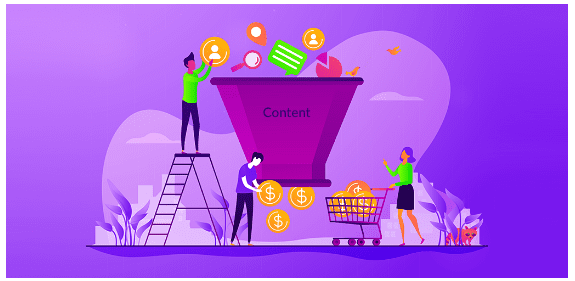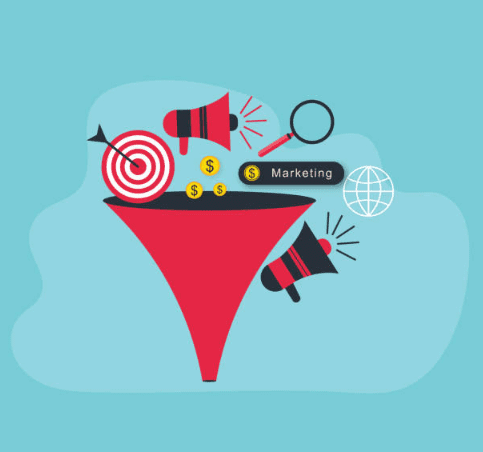Table of Contents
ToggleMiddle funnel content is essential for driving conversions, as it helps to educate potential customers about your product or service and convince them to take action. This type of content is typically more in-depth than top-of-funnel content but could be more specific than bottom-of-funnel content.
To create effective middle funnel content, it’s essential to understand your target audience and their needs. Use data and analytics to identify pain points and typical questions potential customers may have, and tailor your content to address these concerns.
One effective way to create middle funnel content is by creating informative guides, webinars, or e-books that offer valuable insights and tips related to your product or service. You can also use case studies and customer testimonials to demonstrate the benefits of your offering and build trust with your audience.
Remember to optimize your content for SEO by incorporating relevant keywords and meta descriptions and promoting your content through social media and other channels. Creating high-quality, informative content that resonates with your audience can drive conversions and build a loyal customer base.
Introduction to Middle Funnel Content
Middle funnel content refers to the type of content that is created to engage potential customers who are already aware of your brand and are considering purchasing your product or service. It sits between top-of-funnel (TOFU) content that aims to attract new visitors to your website and bottom-of-funnel (BOFU) content designed to convert leads into paying customers.
Middle-funnel content is critical because it helps to educate your audience and establish your brand as a trusted authority in your industry. By providing valuable information and insights about your product or service, you can build trust and credibility with potential customers and help them to make informed purchase decisions.
Examples of middle funnel content include product guides, case studies, webinars, and whitepapers. These types of content aim to inform, educate and engage potential customers while also highlighting the benefits and unique selling points of your offering.
When creating middle funnel content, it’s essential to ensure it is informative, engaging, and relevant to your target audience. Doing so can improve the chances of converting leads into paying customers and building a loyal customer base.
Middle funnel content and its role in driving leads and conversions
Middle funnel content is critical in driving leads and conversions by educating and nurturing potential customers who are already aware of your brand and considering your product or service.
Unlike top-of-funnel (TOFU) content focused on generating traffic and bottom-of-funnel (BOFU) content designed to close the sale, the middle-funnel range is designed to educate and inform potential customers about your offering and convince them to take action.
By creating high-quality, informative content such as webinars, guides, case studies, and whitepapers, you can establish your brand as a trusted authority in your industry and provide valuable insights that help potential customers make informed purchase decisions.
Middle funnel content can also help you to build a relationship with your audience and nurture them through the buyer’s journey. By providing relevant information and addressing common questions or concerns, you can build trust and credibility with potential customers and improve the chances of converting them into paying customers.
To make the most of your middle funnel content, it’s essential to use data and analytics to understand your audience’s needs and pain points. This will help you create relevant, engaging content that addresses the specific challenges and questions that potential customers may have. Doing so can improve your chances of driving leads and conversions and growing your business.

The benefits and challenges of using middle funnel content in marketing and sales efforts
Middle funnel content has many benefits for marketing and sales efforts, including:
- Educating potential customers: By providing detailed information about your product or service, middle funnel content can help potential customers make informed purchase decisions.
- Establishing your brand as an authority: By creating high-quality content that addresses common questions and concerns, you can select your brand as a trusted authority in your industry.
- Building relationships with potential customers: You can build relationships, and nurture leads through the buyer’s journey by providing valuable insights and engaging with potential customers.
- Improving conversion rates: Addressing specific pain points and challenges can improve the chances of converting leads into paying customers.
However, there are also some challenges associated with using middle funnel content in marketing and sales efforts, including:
- Creating high-quality content: Middle funnel content requires in-depth research and expertise, which can be time-consuming and expensive.
- Maintaining engagement: With so much online content, keeping potential customers engaged with your content and interested in your brand can be challenging.
- Balancing content with sales pitches: It’s essential to balance providing valuable information and promoting your product or service, as too much of a sales pitch can turn potential customers off.
The benefits of using middle funnel content in marketing and sales outweigh the challenges. Still, it’s essential to strategically approach content creation and continually analyze and adjust your approach based on data and feedback.
Critical Elements of Effective Middle Funnel Content
Effective middle-funnel content is critical to any successful marketing and sales strategy. To create content that engages and converts potential customers, there are several vital elements to keep in mind:
- Relevance: Middle funnel content should be tailored to your target audience’s specific needs and pain points. Use data and analytics to understand your audience’s challenges and interests and create content that directly addresses these concerns.
- Value: Middle funnel content should provide valuable insights and information that help potential customers make informed purchase decisions. Avoid purely promotional or overly self-serving content and instead focus on providing practical, actionable information.
- Clarity: Middle funnel content should be easy to understand and navigate. Use clear headings, subheadings, and bullet points to break up long blocks of text, and use visuals and multimedia to illustrate critical points.
- Authenticity: Middle funnel content should reflect your brand’s unique voice and values. Avoid generic or overly sales language; instead, aim for a tone that is authentic, engaging, and relevant to your target audience.
- Optimization: Middle funnel content should be optimized for search engines and social media. Use relevant keywords, meta descriptions, and alt tags to improve visibility and promote your content through social media and other channels to drive traffic and engagement.
By incorporating these key elements into your middle funnel content strategy, you can create content that engages and converts potential customers and helps to grow your business.
Developing a deep understanding of target audience needs and pain points
Understanding your target audience’s needs and pain points is crucial for creating effective middle-funnel content that engages and converts potential customers. Here are some tips for developing this understanding:
- Conduct market research: Use surveys, interviews, and focus groups to gather data about your target audience’s challenges, goals, and preferences.
- Analyze customer data: Use analytics tools to analyze the website and social media traffic, sales data, and customer feedback to identify patterns and trends.
- Build buyer personas: Develop detailed profiles of your ideal customers, including demographic information, goals, challenges, and pain points.
- Listen to feedback: Pay attention to customer feedback on social media, review sites, and customer service channels to identify common complaints and issues.
- Monitor industry trends: Stay current on industry trends and changes in the competitive landscape to anticipate customer needs and preferences changes.
By deeply understanding your target audience’s needs and pain points, you can create middle-funnel content that speaks directly to their concerns and provides valuable insights and solutions. This can build trust and credibility with potential customers and improve your chances of converting leads into paying customers.

Creating engaging and educational content that addresses specific audience challenges and questions
Creating engaging and educational content that addresses specific audience challenges and questions is critical for developing effective middle-funnel content that converts potential customers. Here are some tips for making this type of content:
- Identify audience pain points: Use market research and customer feedback to identify the specific challenges and pain points that your target audience is facing.
- Create targeted content: Develop content that speaks directly to these challenges and pain points, offering practical solutions and insights relevant to your audience’s needs.
- Provide in-depth information: Middle funnel content should be more in-depth than top-of-funnel content, offering detailed information and insights that help potential customers make informed purchase decisions.
- Use multimedia: Use a variety of multimedia elements, such as images, videos, and infographics, to make your content more engaging and accessible.
- Optimize for search engines: Use relevant keywords, meta descriptions, and other optimization techniques to improve visibility and attract traffic to your content.
By creating engaging and educational content that addresses specific audience challenges and questions, you can establish your brand as a trusted authority in your industry, build relationships with potential customers, and improve your chances of converting leads into paying customers.
Providing clear calls to action and next steps to move leads through the funnel
Providing clear calls to action and next steps is crucial for moving leads through the funnel and converting them into paying customers. Here are some tips for creating effective calls to action (CTAs) and the next steps in your middle funnel content:
- Be specific: Use unambiguous language to tell potential customers what you want them to do next, such as “Download our e-book” or “Register for our webinar.”
- Make it prominent: Use design elements like color, placement, and size to make your CTA stand out and attract attention.
- Offer incentives: Provide a clear and compelling reason for potential customers to take action, such as offering a free trial or discount.
- Use urgency: Create a sense of urgency by using language emphasizing the importance of taking action now, such as “Limited time offer” or “Only a few spots left.”
- Provide next steps: Once a potential customer has taken action on your CTA, provide clear next steps that move them further down the funnel, such as scheduling a consultation or purchasing.
By providing clear calls to action and the next steps in your middle funnel content, you can guide potential customers through the buyer’s journey and improve your chances of converting leads into paying customers.
Leveraging interactive and multimedia content formats, such as webinars and interactive calculators, to increase engagement and conversion rates
Leveraging interactive and multimedia content formats like webinars and interactive calculators can significantly increase engagement and conversion rates in your middle funnel content. Here are some ways to incorporate these formats:
- Webinars: Host webinars that provide in-depth information about your product or service and offer a Q&A session to address specific audience questions and concerns.
- Interactive calculators: Develop interactive calculators or quizzes that allow potential customers to see the potential benefits of your product or service in real-time.
- Videos: Create engaging and informative videos that showcase your product or service, and provide valuable insights and tips related to your industry or niche.
- Infographics: Develop visually appealing infographics that communicate complex information clearly and easily digestibly.
- Virtual events: Host virtual events such as workshops or product demos that provide hands-on experience and allow potential customers to engage with your brand directly.
By leveraging these interactive and multimedia content formats, you can increase engagement and improve the chances of converting leads into paying customers. These formats can also help establish your brand as a thought leader in your industry, build trust with potential customers, and provide valuable insights and information to inform their purchase decisions.

Best Practices for Creating and Implementing Middle Funnel Content
Creating and implementing effective middle funnel content requires a strategic approach and a deep understanding of your target audience. Here are some best practices to keep in mind:
- Conduct market research: Use market research to identify your target audience’s needs and pain points and create content that addresses these concerns.
- Develop buyer personas: Develop detailed profiles of your ideal customers, including demographic information, goals, and pain points, to guide your content creation.
- Create a content calendar: Develop a content calendar that outlines your content strategy, including topics, formats, and timelines.
- Focus on value: Ensure your content provides value to your target audience, offering actionable insights and solutions to their challenges.
- Optimize for SEO: Use relevant keywords, meta descriptions, and other optimization techniques to improve visibility and attract traffic to your content.
- Promote your content: Use social media, email marketing, and other channels to promote your content and drive engagement.
- Analyze and adjust: Continually analyze your content’s performance and adapt your strategy based on data and feedback from your target audience.
By following these best practices, you can create and implement middle-funnel content that engages and converts potential customers, builds relationships, and drives business growth.
Final Thoughts
Middle-funnel content is a critical component of any successful marketing and sales strategy. By creating informative, engaging, and relevant content that addresses your target audience’s specific needs and pain points, you can establish your brand as a trusted authority in your industry, build relationships with potential customers, and improve your chances of converting leads into paying customers.
To create effective middle funnel content, conducting market research, developing buyer personas, and creating a content calendar that guides your strategy—focusing on value, optimizing for SEO, and promoting your content through social media and other essentials are also important. By continually analyzing and adjusting your system based on data and feedback, you can improve your chances of success and drive business growth.
Remember, creating effective middle funnel content is an ongoing process that requires a deep understanding of your target audience’s needs and preferences and a commitment to delivering high-quality, engaging content that speaks directly to their concerns. With the right approach and strategy, middle funnel content can help to drive leads, conversions, and business growth.
- Success vs. Significance: Understanding the Difference and Achieving Both - October 1, 2023
- 8 Steps to SaaS Success: From Idea to Business - September 30, 2023
- The Importance of Testing in SaaS: Ensure Quality and Success - September 29, 2023